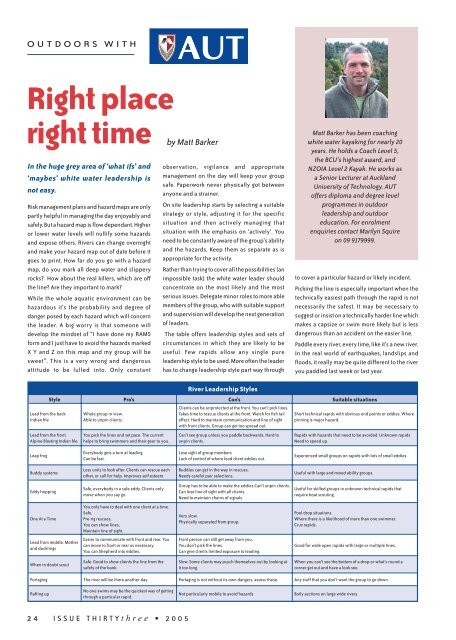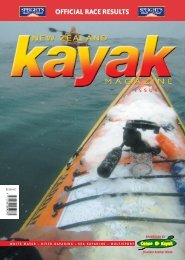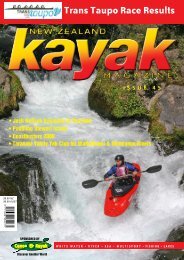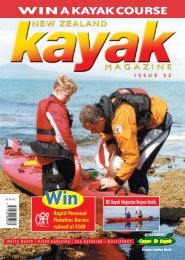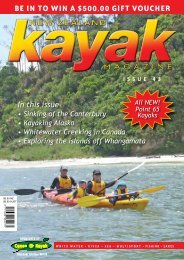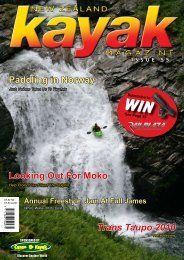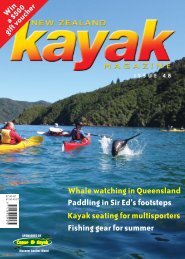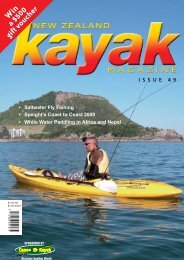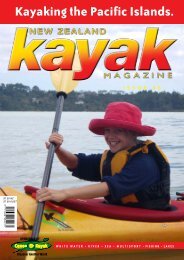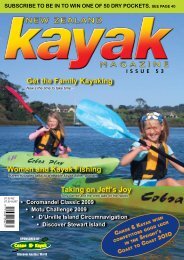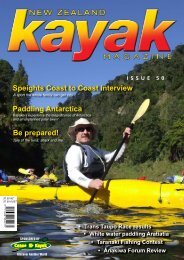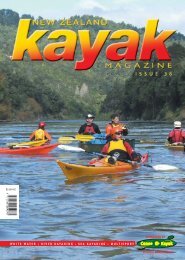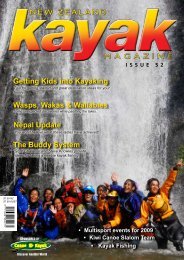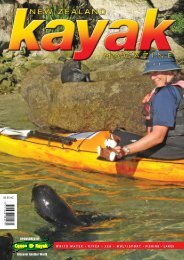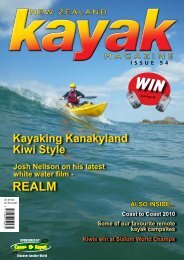SAVEwith a - Canoe & Kayak
SAVEwith a - Canoe & Kayak
SAVEwith a - Canoe & Kayak
Create successful ePaper yourself
Turn your PDF publications into a flip-book with our unique Google optimized e-Paper software.
OUTDOORS WITH<br />
Right place<br />
right time by Matt Barker<br />
In the huge grey area of ‘what ifs’ and<br />
‘maybes’ white water leadership is<br />
not easy.<br />
Risk management plans and hazard maps are only<br />
partly helpful in managing the day enjoyably and<br />
safely. But a hazard map is flow dependant. Higher<br />
or lower water levels will nullify some hazards<br />
and expose others. Rivers can change overnight<br />
and make your hazard map out of date before it<br />
goes to print. How far do you go with a hazard<br />
map, do you mark all deep water and slippery<br />
rocks? How about the real killers, which are off<br />
the line? Are they important to mark?<br />
While the whole aquatic environment can be<br />
hazardous it’s the probability and degree of<br />
danger posed by each hazard which will concern<br />
the leader. A big worry is that someone will<br />
develop the mindset of “I have done my RAMS<br />
form and I just have to avoid the hazards marked<br />
X Y and Z on this map and my group will be<br />
sweet”. This is a very wrong and dangerous<br />
attitude to be lulled into. Only constant<br />
observation, vigilance and appropriate<br />
management on the day will keep your group<br />
safe. Paperwork never physically got between<br />
anyone and a strainer.<br />
On site leadership starts by selecting a suitable<br />
strategy or style, adjusting it for the specific<br />
situation and then actively managing that<br />
situation with the emphasis on ‘actively’. You<br />
need to be constantly aware of the group’s ability<br />
and the hazards. Keep them as separate as is<br />
appropriate for the activity.<br />
Rather than trying to cover all the possibilities (an<br />
impossible task) the white water leader should<br />
concentrate on the most likely and the most<br />
serious issues. Delegate minor roles to more able<br />
members of the group, who with suitable support<br />
and supervision will develop the next generation<br />
of leaders.<br />
The table offers leadership styles and sets of<br />
circumstances in which they are likely to be<br />
useful. Few rapids allow any single pure<br />
leadership style to be used. More often the leader<br />
has to change leadership style part way through<br />
Matt Barker has been coaching<br />
white water kayaking for nearly 20<br />
years. He holds a Coach Level 5,<br />
the BCU’s highest award, and<br />
NZOIA Level 2 <strong>Kayak</strong>. He works as<br />
a Senior Lecturer at Auckland<br />
University of Technology. AUT<br />
offers diploma and degree level<br />
programmes in outdoor<br />
leadership and outdoor<br />
education. For enrolment<br />
enquiries contact Marilyn Squire<br />
on 09 9179999.<br />
to cover a particular hazard or likely incident.<br />
Picking the line is especially important when the<br />
technically easiest path through the rapid is not<br />
necessarily the safest. It may be necessary to<br />
suggest or insist on a technically harder line which<br />
makes a capsize or swim more likely but is less<br />
dangerous than an accident on the easier line.<br />
Paddle every river, every time, like it’s a new river.<br />
In the real world of earthquakes, landslips and<br />
floods, it really may be quite different to the river<br />
you paddled last week or last year.<br />
Lead from the back<br />
Indian file<br />
River Leadership Styles<br />
Style Pro’s Con’s Suitable situations<br />
Lead from the front.<br />
Alpine Blasting Indian file.<br />
Whole group in view.<br />
Able to unpin clients.<br />
You pick the lines and set pace. The current<br />
helps to bring swimmers and their gear to you.<br />
Clients can be unprotected at the front. You can’t pick lines.<br />
Takes time to rescue clients at the front. Watch for fish tail<br />
effect. Hard to maintain communication and line of sight<br />
with front clients. Group can get too spread out.<br />
Can’t see group unless you paddle backwards. Hard to<br />
unpin clients.<br />
Short technical rapids with obvious end points or eddies. Where<br />
pinning is major hazard.<br />
Rapids with hazards that need to be avoided. Unknown rapids<br />
Need to speed up.<br />
Leap frog<br />
Everybody gets a turn at leading.<br />
Can be fast.<br />
Lose sight of group members<br />
Lack of control of where lead client eddies out.<br />
Experienced small groups on rapids with lots of small eddies.<br />
Buddy systems<br />
Less units to look after. Clients can rescue each<br />
other, or call for help. Improves self esteem.<br />
Buddies can get in the way in rescues.<br />
Needs careful pair selections.<br />
Useful with large and mixed ability groups.<br />
Eddy hopping<br />
One At a Time<br />
Lead from middle. Mother<br />
and ducklings<br />
Safe, everybody in a safe eddy. Clients only<br />
move when you say go.<br />
You only have to deal with one client at a time.<br />
Safe.<br />
Pre-rig rescues.<br />
You can show lines,<br />
Maintain line of sight.<br />
Easier to communicate with front and rear. You<br />
can move to front or rear as necessary.<br />
You can Shepherd into eddies.<br />
Group has to be able to make the eddies.Can’t unpin clients.<br />
Can lose line of sight with all clients.<br />
Need to maintain chains of signals.<br />
Very slow.<br />
Physically separated from group.<br />
Front person can still get away from you.<br />
You don’t pick the lines.<br />
Can give clients limited exposure to leading.<br />
Useful for skilled groups in unknown technical rapids that<br />
require boat scouting.<br />
Pool drop situations.<br />
Where there is a likelihood of more than one swimmer.<br />
Crux rapids.<br />
Good for wide open rapids with large or multiple lines.<br />
When in doubt scout<br />
Safe. Good to show clients the line from the<br />
safety of the bank.<br />
Slow. Some clients may psych themselves out by looking at<br />
it too long.<br />
When you can’t see the bottom of a drop or what’s round a<br />
corner get out and have a look see.<br />
Portaging The river will be there another day. Portaging is not without its own dangers, assess these. Any stuff that you don’t want the group to go down<br />
Rafting up<br />
No one swims may be the quickest way of getting<br />
through a particular rapid.<br />
Not particularly mobile to avoid hazards<br />
Boily sections on large wide rivers.<br />
24 ISSUE THIRTYthree • 2005


